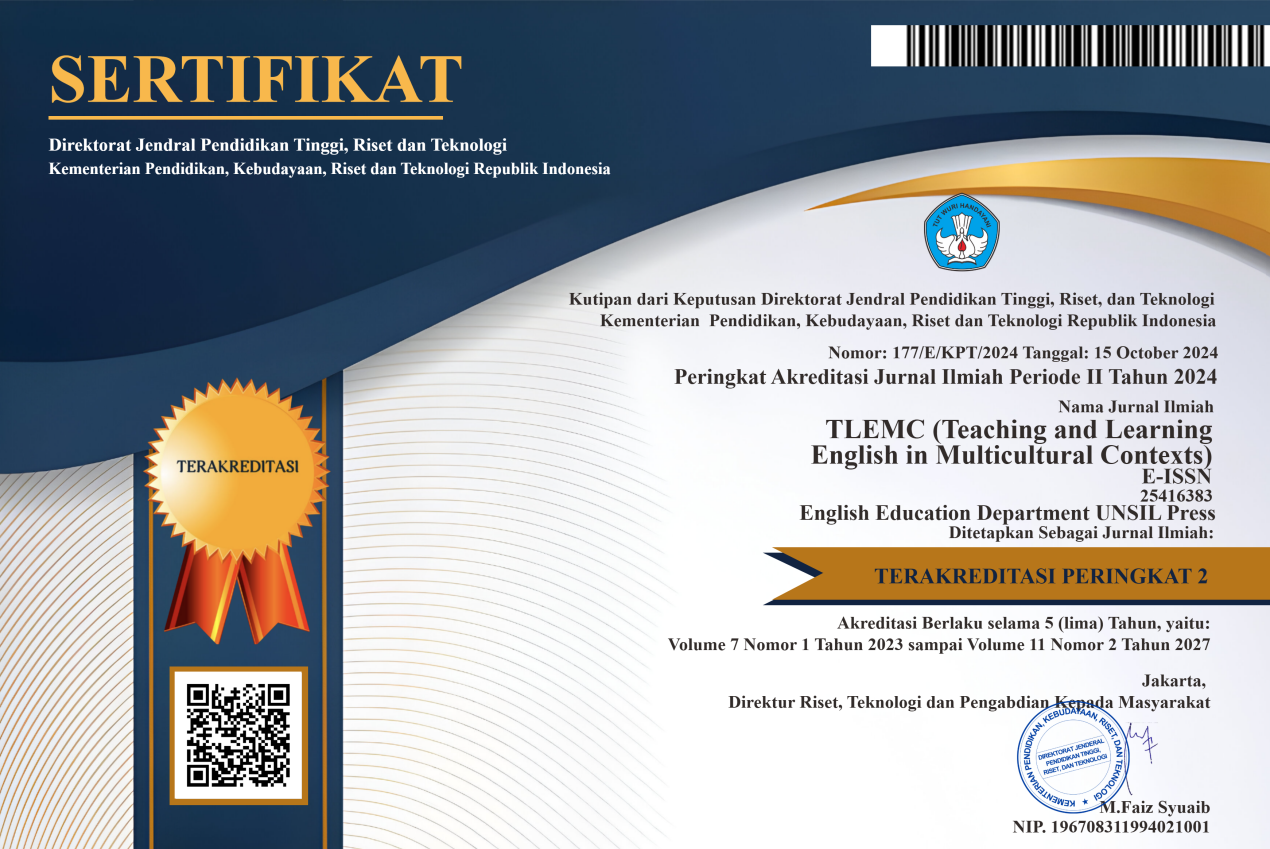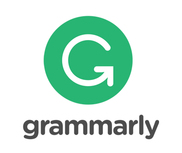Non-English speakers' perspectives on the utilization of Padlet
Abstract
This study sought to ascertain EFL students' perspectives regarding the utilization of Padlet in writing. This investigation was conducted with first-year students. This study involves four students from three classes of an Economy and Social Science Department of a state pedagogical university in Russia. The sampling was conducted purposefully according to the criteria established by the researchers. The study uses qualitative descriptive and employed case study methodologies. Data gathering was conducted through interviews. The findings indicated three student affective perspectives about the use of Padlet in writing: 1). Utility: students are able to compose phrases in English on Padlet, while others are unable to do so. 2) Usability: Students see writing tasks in English on Padlet as straightforward. 3) Accessibility: Students believe the learning process on Padlet is readily accessible, while some find it challenging to navigate. The inquiry into this study's outcomes revealed that many students encountered challenges in the online learning process, specifically identifying inadequate internet access and unstable network connectivity as impediments to their effective and timely participation in lessons on Padlet.
Keywords: Asynchronous learning, Padlet, Non-English speaker, Student’s perception, Russian students
Full Text:
PDFReferences
Alwahoub, H. M. (2020). The impact of synchronous collaborative writing on students’ individual writing competence [Unpublished Master’s dissertation].
Amdriyani, R. P. (2016). Comparative Study of Reading Comprehension Between Students With Introvert and Students with Extrovert Personality At Sma N 2 Kalianda.
Banegas, D. L., & Lowe, R. J. (2021). Creative writing for publication: An action research study of motivation, engagement, and language development in Argentinian secondary schools. Studies in Second Language Learning and Teaching, 11(3), 401–421. https://doi.org/10.14746/ssllt.2021.11.3.5
Bhatti, M. S., Iqbal, A., Rafique, Z., Noreen, S., & Tabassum, F. (2022). Short stories as an innovative EFL teaching technique to improve Pakistani elementary students’ English vocabulary. Journal on English as a Foreign Language, 12(2), 405–420. https://doi.org/10.23971/jefl.v12i2.4060
Burston, J. (2024). MALL: The pedagogical challenges. Computer Assisted Language Learning, 27(4), 344–357. https://doi.org/10.1080/09588221.2014.914539
Chamot, A. (1999). Learning Strategy Instruction in the English Classroom.
Davis, D. Fred .(1989). Perceived usefulness, perceived ease of use, and user acceptance of information technology. MIS Quarterly 13(3), 319-339.
Delcker, J., & Ifenthaler, D. (2022). Digital Distance Learning and the Transformation of Vocational Schools From a Qualitative Perspective. Frontiers in Education, 7. https://www.frontiersin.org/articles/10.3389/feduc.2022.908046
Eslami, Z. R., Mirzaei, A., & Dini, S. (2015). The role of asynchronous computer mediated communication in the instruction and development of EFL learners' pragmatic competence. System, 48, 99-111.
Godwin-Jones, R. (2011). Mobile apps for language learning. Language Learning & Technology, 15(2), 2–11.
Goold, A., Coldwell, J., & Craig, A. (2010). An examination of the role of the e-tutor. 26(5). https://doi.org/704-716. https://doi.org/10.14742/ajet.1060
Irianto, D. G., & Hadi, M. S. (2022). The Challenges of Teaching Practice for Students Mastering Vocabulary in Blended Learning. Scripta : English Department Journal, 9(2), 147–157. https://doi.org/10.37729/scripta.v9i2.2217
Koob, A. R., Oliva, K. S. I., Williamson, M., Lamont-Manfre, M., Hugen, A., & Dickerson, A. (2022). Tech tools in pandemic-transformed information literacy instruction: Pushing for digital accessibility. Information Technology and Libraries, 41(4).
Maksus, A. (2012). The Analysis of the Types of Reading Text and the Comprehension Level of the Exercises Found in “Get Along with English for Vocational High School Gradde XI Elementary Level” Used in the Second Year of Vocational High School.
Marzuki, A., & Santiana, S. (2021). Using Padlet as a digital tool for enhancing EFL students’ collaborative writing. https://doi.org/10.31219/osf.io/tjgq9
Maskuri, E., Hakim, Y., Ashari, A., & Supriyono, S. (2018). Integrated Technology And Mutual Participation For Changing Communities Socially, Economically And Religiously. Proceedings of the 1st International Conference on Science and Technology for an Internet of Things.
Masykuri, E. S. (2022). Technology effect of efl listening comprehension to teacher during pandemic. Journal of English Teaching and Learning Issues, 5(1), 51-62.
Masykuri, E., Mezentse, I., M.S, N., Anastasi, N., & Kamin, Y. (2024). New Perspectives of Flipbook as Asynchronous English Reading Media. Journal of Languages and Language Teaching, 12, 1538. https://doi.org/10.33394/jollt.v12i3.11352
Nikijuluw, R. C. V. (2017, August). Enriching Students' Vocabulary by Implementing Semantic Mapping Strategy at the Tenth Grade of SMK Negeri 1 Ambon. In International Conference on English Language Teaching (ICONELT 2017) (pp. 195-200). Atlantis Press.
Novianto, A., Rohayati, D., & Faridah, D. (2024). Padlet as Learning Media to Improve Students’ Writing Skills: EFL Teacher’s and Students’ Perspective. Journal of English Education Program (JEEP), 11, 73. https://doi.org/10.25157/(jeep).v11i1.13563
Pertiwi, E. A. I. (2012). The Study Reading Ability on Descriptive Text of The Fifth Grade Students of SD Sebomenggalan in The Academic Year 2012/2013.
Prihatini, N., Sudar, S., & Edi Sunjayanto Masykuri. (2023). The Impact of Using Blended Learning to Improve Reading Comprehension. Scripta : English Department Journal, 10(1), 128–139.
Rehman, A., Ahmed, N., Naeem, M., & Lodhi, M. A. (2025). Integrating 'Padlet' as Interactive Teaching Tool for English Language Learners: An Experimental Study. Competitive Research Journal Archive, 3(2), 43-54.
Rosell-Aquilar, F. (2017). State of the app: A taxonomy and framework for evaluating language learning mobile applications. CALICO Journal, 34(2), 243–258. https://doi.org/10.1558/cj.27623
Ryan, R. M., & Deci, E. L. (2000). Intrinsic and extrinsic motivations: Classic definitions and new directions. Contemporary educational psychology, 25(1), 54-67.
Sadry, Z. (2023). The Use of Padlet as an Educational Technology Tool in EFL Classrooms. https://doi.org/10.13140/RG.2.2.29052.82567
Saichun Nizar, A. I. (2020). Teaching Vocabulary Using Digital Media During Covid-19 Pandemic. Jurnal Penelitian, Pendidikan, Dan Pembelajaran, 15(30).
Santiana, S., Silvani, D., & Ruslan, R. (2021). Optimizing LMS CANVAS for interactive online learning perceived by the students. Journal of English Education and Teaching, 5(4), 529-543.
Savaşçi, M., & Kaygisiz, S. (2019). One hand washes the other and both wash the face: Individuality versus collaboration in L2 writing. Eurasian Journal of Applied Linguistics, 5(1), 131–151. https://doi.org/10.32601/ejal.543789
Silvani, D. (2020). Learning through watching: using animation movie to improve students’ writing ability. Journal of English Language Teaching and Linguistics, 5(2), 233-247.
Sudrajat, M. F., Ngafif, A., & Masykuri, E. S. (2021). The Correlation between Students’ habit in watching western-movie and listening skill. Scripta: English Department Journal, 7 (2), 25–34.
Tajeddin, Z., & Hosseinpur, R. (2014). The impact of deductive, inductive, and L1-based consciousness-raising tasks on EFL learners' acquisition of the request speech act. Teaching English as a Second Language Quarterly (Formerly Journal of Teaching Language Skills), 33(1), 73-92.
Terenin, A. (2020). Awkward Writing as the Problem of Russian Learners of English (p. 2551). https://doi.org/10.3897/ap.2.e2533
Zainuddin, N. M. M., Azmi, N. F. M., Yusoff, R. C. M., Shariff, S. A., & Hassan, W. A. W. (2020). Enhancing classroom engagement through Padlet as a learning tool: A case study. International Journal of Innovative Computing, 10(1).
DOI: https://doi.org/10.37058/tlemc.v8i2.13440
Refbacks
- There are currently no refbacks.
INDEXED BY:
This work is licensed under a Creative Commons Attribution-NonCommercial-ShareAlike 4.0 International License.
![]()
TLEMC (Teaching and Learning English in Multicultural Contexts)
Program Studi Pendidikan Bahasa Inggris
Fakultas Keguruan dan Ilmu Pendidikan
Universitas Siliwangi
Jl. Siliwangi No. 24 Kota Tasikmalaya - 46115
email: tlemc@unsil.ac.id





